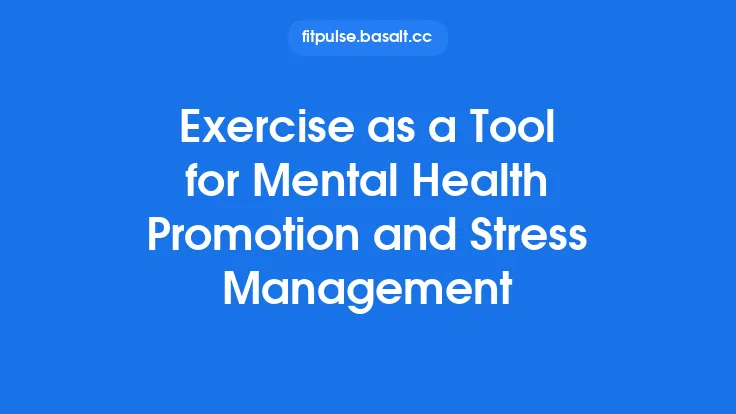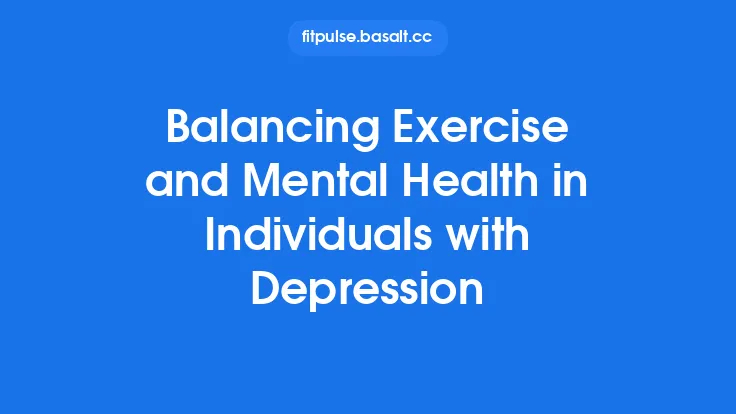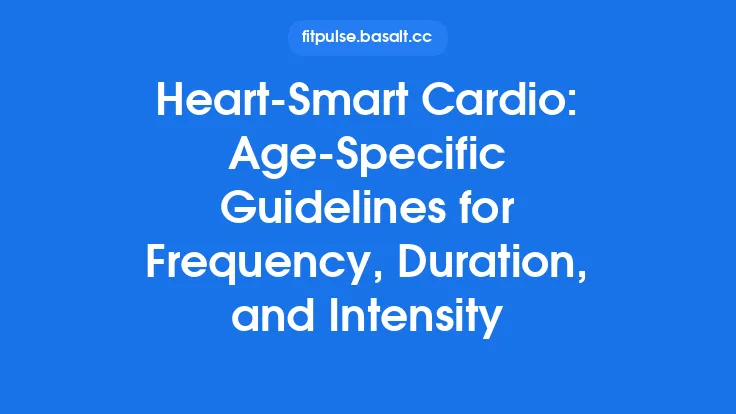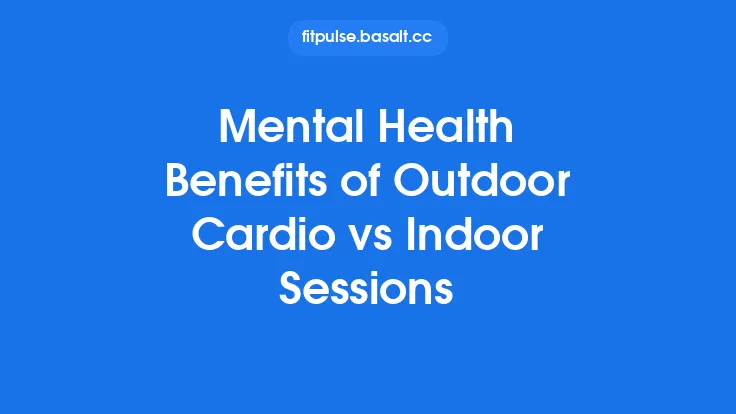Aerobic exercise is one of the most accessible tools for managing everyday stress. When you lace up your shoes and move at a moderate‑to‑vigorous pace, your body initiates a cascade of hormonal and neural responses that directly counteract the stress hormone cortisol. Over time, these adaptations translate into measurable improvements in mood, anxiety levels, and overall mental resilience. Below, we explore the science behind cortisol regulation, the neurobiological pathways that link cardio to mental well‑being, and practical guidelines for designing a stress‑busting aerobic routine that you can sustain for the long haul.
The Hormonal Landscape of Stress: Why Cortisol Matters
Cortisol, often dubbed the “stress hormone,” is produced by the adrenal cortex in response to activation of the hypothalamic‑pituitary‑adrenal (HPA) axis. In acute situations, cortisol helps mobilize energy, sharpen cognition, and modulate immune function. However, chronic elevation—common in high‑pressure jobs, caregiving roles, or persistent anxiety—can:
- Impair memory consolidation and retrieval.
- Disrupt mood regulation, contributing to depression and irritability.
- Promote visceral fat accumulation and metabolic dysregulation (outside the scope of weight‑management discussions).
- Suppress immune surveillance, increasing susceptibility to illness.
The goal of stress‑busting cardio is not to eliminate cortisol entirely—its presence is essential—but to restore a healthy diurnal rhythm and attenuate exaggerated spikes that underlie chronic stress.
How Aerobic Exercise Modulates the HPA Axis
1. Acute Cortisol Response and Adaptation
During a single bout of moderate‑intensity cardio (e.g., brisk walking, cycling at 60–70 % of VO₂max), cortisol rises modestly, peaking around 20–30 minutes into the activity. This rise is part of the body’s normal mobilization response. Importantly, repeated exposure leads to habituation: the same exercise stimulus elicits a blunted cortisol surge over weeks, indicating improved HPA axis efficiency.
2. Down‑Regulation of CRH and ACTH
Chronic aerobic training reduces the sensitivity of the hypothalamus to corticotropin‑releasing hormone (CRH) and the pituitary to adrenocorticotropic hormone (ACTH). Animal studies have shown decreased CRH mRNA expression after 8 weeks of treadmill running, while human trials report lower resting ACTH concentrations in trained individuals.
3. Enhancement of Negative Feedback Loops
Glucocorticoid receptors (GR) in the hippocampus and prefrontal cortex mediate cortisol’s negative feedback. Aerobic exercise up‑regulates GR density and improves receptor affinity, allowing the brain to more effectively signal the HPA axis to shut down cortisol production after a stressor has passed.
Neurochemical Allies: Endorphins, Serotonin, Dopamine, and BDNF
Beyond cortisol, cardio stimulates a suite of neurotransmitters that collectively uplift mood and sharpen cognition.
| Neurochemical | Primary Effect | Cardio‑Induced Change |
|---|---|---|
| β‑endorphins | Analgesia, euphoria (“runner’s high”) | ↑ plasma levels after 30 min of moderate‑intensity exercise |
| Serotonin | Mood stabilization, anxiety reduction | ↑ synthesis via enhanced tryptophan uptake; chronic training raises baseline serotonergic tone |
| Dopamine | Motivation, reward processing | ↑ release in the striatum during sustained aerobic activity |
| Brain‑Derived Neurotrophic Factor (BDNF) | Neurogenesis, synaptic plasticity | ↑ serum BDNF after 20–40 min of vigorous cardio; linked to improved executive function |
These chemicals act synergistically: endorphins blunt pain perception, serotonin dampens anxiety, dopamine fuels reward pathways, and BDNF supports the structural remodeling needed for lasting mental health benefits.
Autonomic Balance: Heart‑Rate Variability as a Stress Indicator
Heart‑rate variability (HRV) reflects the interplay between sympathetic (fight‑or‑flight) and parasympathetic (rest‑and‑digest) nervous system activity. Higher HRV is associated with greater stress resilience. Regular aerobic training:
- Increases vagal tone, raising the high‑frequency component of HRV.
- Lowers resting heart rate, indicating a more efficient cardiovascular system.
- Improves HRV recovery post‑exercise, a marker of rapid autonomic re‑equilibration.
Monitoring HRV (via wearable devices or simple pulse‑oximetry) can provide real‑time feedback on how well your cardio regimen is tempering stress.
Designing a Cortisol‑Friendly Cardio Program
| Variable | Recommended Range | Rationale |
|---|---|---|
| Frequency | 3–5 sessions per week | Allows sufficient stimulus while providing recovery days to prevent over‑activation of the HPA axis |
| Duration | 30–45 minutes per session | Sustains the acute cortisol rise long enough to trigger adaptation without excessive hormonal load |
| Intensity | 60–75 % of VO₂max (moderate) or 75–85 % (vigorous) | Moderate intensity optimizes cortisol habituation; occasional vigorous intervals boost endorphin and BDNF responses |
| Mode | Continuous (running, cycling, rowing) or interval (1 min high/2 min low) | Variety prevents monotony, engages different neural pathways, and can be tailored to personal preference |
| Progression | Increase volume by ≤10 % per week or add 5‑minute increments every 2 weeks | Gradual overload ensures continued HPA axis adaptation without triggering chronic stress |
Sample Week
| Day | Activity | Intensity | Duration |
|---|---|---|---|
| Mon | Brisk walk or light jog | 65 % VO₂max | 35 min |
| Tue | Rest or gentle yoga (non‑cardio) | — | — |
| Wed | Cycling with 2 × 3‑min high‑intensity intervals | 80 % VO₂max (intervals) | 40 min |
| Thu | Rest or active recovery (stretching) | — | — |
| Fri | Swimming (steady) | 70 % VO₂max | 45 min |
| Sat | Hiking (inclines) | 70 % VO₂max | 45 min |
| Sun | Rest | — | — |
Practical Tips for Maximizing Mental Benefits
- Consistency Over Intensity – Regular moderate sessions are more effective for cortisol regulation than sporadic high‑intensity bursts.
- Environment Matters – Outdoor cardio (parks, trails) adds natural light exposure, which supports circadian cortisol rhythms.
- Social Component – Exercising with a friend or group can amplify endorphin release and provide emotional support.
- Mind‑Body Integration (Without Formal Breathing Techniques) – Simply paying attention to bodily sensations (e.g., foot strike, breath rhythm) can enhance interoceptive awareness, indirectly reducing perceived stress.
- Post‑Exercise Cool‑Down – A 5‑minute low‑intensity phase helps transition the autonomic system back to parasympathetic dominance, stabilizing cortisol levels.
- Track Mood and Cortisol – Journaling subjective stress levels alongside objective measures (salivary cortisol, HRV) can reveal patterns and motivate adherence.
Evidence Snapshot: What the Research Shows
- Meta‑analysis (2022, 34 RCTs, n = 2,800): Aerobic training reduced basal cortisol by an average of 12 % and lowered self‑reported stress scores (Cohen’s d = 0.45). Effects were strongest in programs ≥12 weeks.
- Longitudinal Cohort (Finnish Health Study, 10 years, n = 5,200): Participants who met the recommended aerobic volume had a 30 % lower incidence of clinically significant anxiety disorders compared with sedentary peers.
- Neuroimaging Study (2021, n = 45): After 8 weeks of treadmill training, functional MRI revealed increased connectivity between the prefrontal cortex and amygdala, correlating with reduced cortisol reactivity to a laboratory stressor.
These findings underscore that the mental health dividends of cardio are not merely anecdotal; they are grounded in measurable physiological change.
Potential Pitfalls and How to Avoid Them
| Issue | Why It Happens | Mitigation |
|---|---|---|
| Overtraining | Excessive volume/intensity can chronically elevate cortisol, negating benefits | Incorporate at least one full rest day per week; monitor HRV for signs of autonomic strain |
| Monotony | Repetitive routines may reduce enjoyment, leading to dropout | Rotate modalities (running, rowing, dance‑based cardio) and vary terrain |
| Ignoring Recovery | Skipping cool‑downs or post‑exercise nutrition can blunt parasympathetic rebound | Allocate 5‑10 minutes for low‑intensity movement and hydrate after each session |
| Underlying Medical Conditions | Certain endocrine disorders (e.g., Cushing’s syndrome) alter cortisol dynamics | Obtain medical clearance before initiating a new cardio program if you have known hormonal issues |
Integrating Cardio into a Holistic Stress‑Management Toolkit
While aerobic exercise is a potent standalone strategy, its impact is amplified when paired with complementary practices:
- Cognitive‑behavioral techniques (e.g., reframing stressors) reinforce the mental resilience built through cardio.
- Sleep hygiene (maintaining consistent bedtime) supports the natural cortisol decline that occurs overnight.
- Mindful leisure activities (reading, art) provide psychological downtime, allowing the HPA axis to reset between workouts.
The synergy of these elements creates a feedback loop: cardio lowers cortisol, which improves mood, making it easier to engage in other stress‑relief activities, which in turn further stabilizes cortisol.
Bottom Line
Aerobic exercise offers a scientifically validated pathway to tame chronic cortisol elevation and boost mental well‑being. By understanding the hormonal and neurochemical mechanisms at play, you can tailor a cardio regimen that not only strengthens the heart and lungs but also fortifies the mind against everyday stressors. Consistency, moderate intensity, and mindful progression are the keystones of a stress‑busting cardio program—tools you can start using today to cultivate a calmer, more resilient self.





